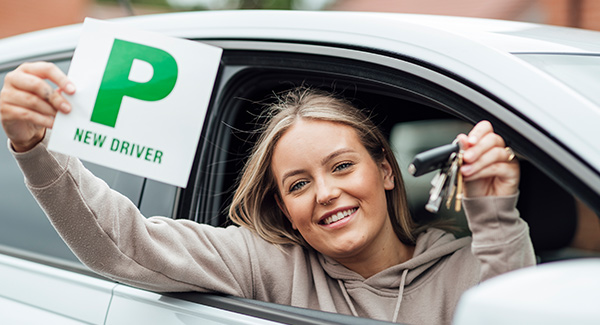How To Teach Someone To Drive
- Editorial Team
There are many reasons to teach someone to drive. Whether it’s to help them practice, build-up their confidence or save money on professional lessons, private practice behind the wheel can give a learner driver invaluable on-road experience. This will prepare them well for their driving test and after they pass.
To ensure you’re giving the learner the correct advice and not passing on any bad habits, we’ve put together a few tips on how to prepare the learner driver safely and successfully for the road.

Talk to their professional driving instructor
Before you take a learner driver out on the road, speak to their professional driving instructor. Find out whether they feel that the learner is ready for private lessons and which areas need improving. You could even sit in on one of the lessons.
Regular communication with the professional instructor will help you structure your lessons better so that they evolve as the learner’s driving improves. It will also ensure that what you’re teaching the learner is relevant.
Assess your own driving style
Brush up on your driving skills and knowledge of the Highway Code. When driving laws change, the Highway Code is updated to reflect these changes. This will help you avoid passing on any bad habits you may have picked up behind the wheel and ensure you’re giving the correct advice.
Driving with a learner
Before supervising a learner driver, there are a few specific learner driver rules you need to know about. You’ll also need to ensure that the learner driver has a valid motor insurance policy in place on the vehicle they intend to practice in.
At A Choice, our car insurance for learner drivers provides short-term and annual comprehensive cover options.
Carry out vehicle safety checks
You’ll need to ensure that the vehicle the learner driver is practicing in is roadworthy and safe to drive. There are a few simple checks you can carry out so that you have a safer journey and help avoid a breakdown.
- Check your lights and indicators are clean, clear and working correctly.
- Make sure there is no damage to the vehicle.
- Brakes are working.
- Check the windows and windscreen are clean inside and out and not damaged.
- Check oil, coolant and screen wash levels are correct.
Check your fuel level
As a rule of thumb, you should always keep your fuel tank at least a quarter full. Whilst this may sound obvious, running out of fuel could cause damage to the car’s engine and may even land you a fine for careless driving. It’s simply not worth taking the risk.
Check your tyres
It’s important to check tyres regularly. Driving with underinflated or overinflated tyres can affect braking distance, steering control and fuel consumption.
In the UK, the legal minimum tread depth for car tyres is 1.6mm. You could receive a fine of up to £2,500 and three penalty points for each bald or defective tyre that does not meet the legal requirements.
Plan the route
Try to be flexible when teaching someone to drive. Remember every road trip you make is an opportunity to learn. The more the learner practices, the safer and more experienced they’ll become.
During the early stages of the learning process, try and avoid practicing in bad weather with poor visibility. But slowly introduce them to different weather conditions as they build up their experience and confidence.
Remember that the goal of private lessons is to allow the learner to practice the skills they’ve gained from their instructor. Try not to teach them new skills, where they can pick up bad habits, or contradict the professional instructor’s advice.
When you take a learner driver out on the roads for the first time, start with quieter, less challenging routes. Depending on the learner’s level of ability, an empty car park or an industrial estate may be good starting locations. This enables them to practice basic control skills and work on some driving manoeuvres.
When planning a journey, you’ll need to think about the time of day you’re practicing and how long the journey will take. Learner drivers can get tired and lose concentration easily, so start with shorter, quieter trips initially. Ask the learner how they feel about the journey beforehand and whether they feel confident enough to drive. Finally, remember to allow plenty of time for your journey.
As the learner gains more experience
As the learner gains more experience, put some practice in on country roads with different speed limits. This will help familiarise the learner with potential hazards in rural areas such as animals and blind bends. It will also help them manage and control their driving speed more effectively.
Allow them to think for themselves more, so that they don’t always rely on your instructions. When they carry out certain driving manoeuvres, you could also ask them to talk you through the process, to ensure they understand what they are doing.
Introduce them to different conditions that reflect the type of roads and trips the learner will experience once they pass, like carriageways and night-time driving. But bear in mind that learner drivers are not allowed on motorways, unless accompanied by an approved driving instructor, in a car with dual controls.
Avoid in-car distractions
Avoid trips with additional passengers that may cause a possible distraction. It’s important that the learner driver is fully focused on the road and what’s going on around them. The last thing they need is a ‘back-seat driver’ telling them how to drive, or enthusiastic children that may reduce their concentration.
Also avoid playing loud music as this may cause a barrier to effective communication.
Remove distractions like mobile phones, switch them off or put them in the glove compartment. Remember that it’s illegal to use a mobile phone while supervising a learner driver. As an instructor you have the same legal responsibilities as if you were driving. And if you’re distracted by your phone, you have less time to react if the learner makes a mistake.
Declutter the practice car, removing any loose items that may move around and cause a distraction.
Your teaching style
Learning to drive is exciting, nerve wracking and stressful. As an instructor, it’s important to put yourself in the learner’s shoes. Think back to when you were learning to drive, how you felt and the challenges you faced.
Learner drivers will make mistakes, so remember to keep calm, be patient and give plenty of encouragement and reassurance. Do not raise your voice or criticise as this can affect the learner’s confidence.
Be clear, concise and give plenty of notice when giving the learner instructions.
Final thoughts
It takes time and practice to learn to drive, so be patient with the learner driver and don’t expect too much too soon. Remember, the more the learner practices, the safer and more experienced they’ll become.
Share this article
Table of Contents
More posts

Do Black Boxes Have Nighttime Driving Restrictions?

How To Give Your Vehicle A Spring Clean

Should You Take An Intensive Driving Course?

